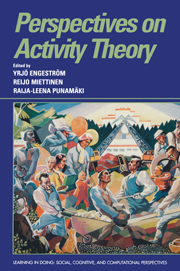Book contents
- Frontmatter
- Contents
- List of contributors
- Series foreword
- Introduction
- Part I Theoretical issues
- 1 Activity theory and individual and social transformation
- 2 The content and unsolved problems of activity theory
- 3 Knowledge as shared procedures
- 4 Activity theory in a new era
- 5 Society versus context in individual development: Does theory make a difference?
- 6 Cultural psychology: Some general principles and a concrete example
- 7 Laws, logics, and human activity
- 8 Collapse, creation, and continuity in Europe: How do people change?
- 9 Activity theory and the concept of integrative levels
- 10 The relevance to psychology of Antonio Gramsci's ideas on activity and common sense
- Part II Language and its acquisition
- Part III Play, learning, and instruction
- Part IV Technology and work
- Part V Therapy and addiction
- Author index
- Subject index
8 - Collapse, creation, and continuity in Europe: How do people change?
Published online by Cambridge University Press: 05 June 2012
- Frontmatter
- Contents
- List of contributors
- Series foreword
- Introduction
- Part I Theoretical issues
- 1 Activity theory and individual and social transformation
- 2 The content and unsolved problems of activity theory
- 3 Knowledge as shared procedures
- 4 Activity theory in a new era
- 5 Society versus context in individual development: Does theory make a difference?
- 6 Cultural psychology: Some general principles and a concrete example
- 7 Laws, logics, and human activity
- 8 Collapse, creation, and continuity in Europe: How do people change?
- 9 Activity theory and the concept of integrative levels
- 10 The relevance to psychology of Antonio Gramsci's ideas on activity and common sense
- Part II Language and its acquisition
- Part III Play, learning, and instruction
- Part IV Technology and work
- Part V Therapy and addiction
- Author index
- Subject index
Summary
Introduction
Recent changes in Europe have been swift and have altered the entire political landscape. As a result, the structures that were established after the Second World War have faded away. The last chain of conversions started with the rebellions in Poland, continued with perestroika in the Soviet Union, and culminated in 1989/1991 in the collapse of the socialist regimes of Eastern Europe. Fixed coalitions known as the Soviet Union, the German Democratic Republic, the Warsaw Pact, and Yugoslavia suddenly collapsed. As a consequence, the tension between the opposing military superpowers was alleviated and deep conflicts within the postsocialist sphere emerged.
But has this development actually been rapid? One may even say that what happened happened too late: What nurtured the tensions within the earlier socialist nations is that many preserved too long their centralist coalitions and provided no space for change. Present-day Europe is full of indications of a new relationship between the individual and society. One of the areas where these indications are manifested is the process of economic and political integration in Western Europe – a type of development seemingly opposite to the disintegration of socialism. How are these changes reflected in day-to-day activities? How swiftly can people change?
Mainstream psychology does not usually concern itself with these kinds of temporal problems. It has been extremely static in its premises and methods. To paraphrase Pierre Bourdieu, academic research has chiefly been concerned with the world of “preconstructed facts” mirroring the conventions of everyday life rather than the hidden, temporal, gender-and class-based flow of social behavior (Bourdieu, 1992).
- Type
- Chapter
- Information
- Perspectives on Activity Theory , pp. 115 - 132Publisher: Cambridge University PressPrint publication year: 1999



